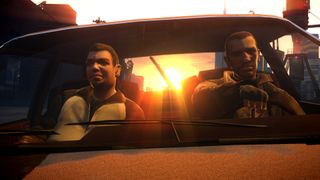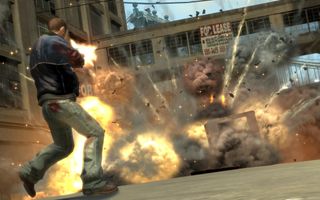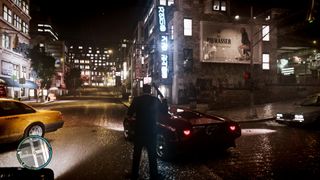It was GTA 4's world, not its story, that made a lasting impression
The incredible detail of GTA 4, and especially its PC port, created a world that felt real like nothing before it.

Grand Theft Auto 4 isn’t really the story of a poor immigrant looking to make his fortune, but the tale of one city. In many ways it’s the culmination of everything that Rockstar had been trying since GTA back in 1997—a generational and design leap that would obviously be built on, as seen in GTA 5 and GTA Online, but which stands out as a Moment Everything Changed. No longer was Liberty City simply an impressive backlot to recreate Dan Houser and co.’s favourite action movies. Now it was a living, breathing place, with the goal of putting its own stamp on the series’ long-running New York analog—as seen in vague form in the original game, and in 2001’s GTA 3.
It was arguably the first big city that truly felt alive
Much of that comes from the choice of character. Unlike Vice City’s playful psychopathy or San Andreas’ rags-to-jetpacks tale, GTA 4 gives us Niko Bellic—a largely broken man at the bottom of the social ladder, who spends most of the story being used and abused by those around him. The opening hours aren’t set in the shining Times Square type parts of not-New York, but the grubby inner city Skid Row parts, where apartment walls rattle to the sound of passing trains and loan sharks and low-level gangsters live like kings amongst the poverty and squalor. There’s a grit to the game that even San Andreas’ gang-focused opening didn’t really offer, with any sense of hope constantly undercut by reminders that the one part of Niko’s past he can’t escape is himself.
There’s never a shortage of life to it all, though. You can write off individual parts of GTA 4 as simply mini-games, or roll your eyes at the execution—the constant phonecalls from Niko’s cousin, Roman, suggest that in this universe bowling is slightly more addictive than heroin—but in bulk they create a city unlike anything we’d seen before. Where past games would throw in something like a strip-club or a burger bar, GTA 4 had working bowling alleys, comedy clubs (complete with real-world funny people and also Ricky Gervais), golf, darts and a fully functional fake-internet full of everything from the blog of one of Niko’s potential girlfriends to a World of Warcraft parody.
Even the taxis contributed, with the ability to warp to destinations at the touch of a button, or to sit back and ride through the city in all its glory, admiring the scenery and the new way that characters ragdoll when hit by cars.

This obviously wasn’t the first 3D city in games. Nor was GTA 3's at the time. But it was arguably the first big city that truly felt alive—like the people around you might actually be living their lives, and that everywhere you looked there was a potential story. This was later backed up by the DLC packs, which didn’t simply add more content, but used the ability to shift perspective to show us different parts of the city.
The Lost And Damned told a story of feuding biker gangs, while The Ballad of Gay Tony lightened the mood considerably with a tale of glitzy nightclubs. Even in the original, though, GTA 4 made it worth taking some time to actively live in rather than simply finish.
At the same time, though, nothing shows the problems with GTA better than the clash between the peerless city and the actual game. As with San Andreas, which expected us to ignore that CJ's brother could be locked up on a false accusation even as the police put CJ himself back on the street after a literal rocket launcher rampage, the two sides don’t always mesh. Rockstar’s insistence on cheap gags like the internet cafe ‘TW@‘ undercuts so much, as does going from stern mob drama to blitzing around the city with all the care of a hyperactive five year old.
The biggest gaming news, reviews and hardware deals
Keep up to date with the most important stories and the best deals, as picked by the PC Gamer team.
Perhaps the biggest problem, and one that would only get worse in GTA 5, was the split between the freedom of the open world and the locked-down nature of the missions. Past GTA games had obviously been scripted affairs, but usually offered some scope for clever ideas and breaking the game in certain ways, like avoiding a police chase by bringing your personal helicopter to the mission and simply flying over all the roadblocks with a hearty finger raised.

GTA 4 on the other hand put the scripted action on rails. Asked to kill someone? They’re going to be invulnerable until you reach the part of the map where their fancy cutscene death is scheduled to take place. Told to drive somewhere? It’ll be in THIS car. Try to do something clever like box in an NPC so they can’t flee, and either your blockade will disappear or the game will find a way of failing the mission until you agree to play properly, as the mission’s author intended.
As of GTA 5, the series still struggles with this problem, even when it’s something like the intro, where you can fail by blowing your cover literal seconds before you’re scripted to blow your cover. It’s an unfortunate case where the high production values really do get in the way of the action, and show that the series’ priorities can be a bit askew. It wasn't a great look even in GTA 4's day, when Saints Row 2 embraced anarchy and really gave no shits how you finished most of its missions. Likewise, as the story progressed, it became harder for it to justify much of the action. As a penniless immigrant, Niko has problems. As a successful bank robber with $30,000 literally in his pocket, he has options, and the writing isn’t strong enough to sell much of what comes later as a good enough reason not to take full advantage of his new wealth.
What matters years later isn’t really how successful any individual element of GTA 4 was, but the massive leap forward it attempted to make—for immersion, for dynamism, and simply the attempt to tell a more meaningful story. The PC version of GTA 4 made its own leaps forward, with more players in its online mode and customization options like custom radio stations. GTA Online wasn't a monster hit at the time, but GTA 5's improvements would later propel it to rake in billions of dollars. And as a canvas for mods, GTA 4 helped kickstart a community of skilled video game photographers, who used graphics and lighting overhauls like iCEnhancer to conjure up striking shots of Liberty City.

Rockstar would subsequently pull off considered, emotional storytelling far better in Red Dead Redemption, both in its main character and in its own bigger but equally carefully implemented setting. It raised the bar while showing what games could aspire to be, and that’s worth all the praise in the world. But no, Roman. We really, really don’t want to go bowling again.

Take-Two CEO says Grand Theft Auto 6 is on track for 'fall' next year, GTA 5 has sold over 205 million, and 'PC will be more and more a part of [our] business going forward'

GTA 6's corporate overlord reveals that he's looking forward to 'a more sensible FTC' under the Trump administration because sometimes 'deregulation can be a positive'
Most Popular

